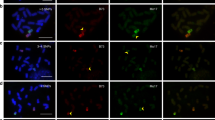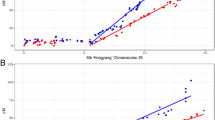Abstract
A detailed analysis, using a modified silver staining technique which permits the visualization of the chromatid cores in bivalents at metaphase I, shows that some so-called chromosome associations are indeed true chiasmata. This study employs a supernumerary segment on the longest of the autosome pairs in the grasshopper Chorthippus jucundus that produces clear asymmetric bivalents in heterozygotes. Clear evidence of crossing over within the supernumerary segment explains part of the polymorphism of this segment, since unequal crossing over can produce different-sized segments. The origin of this segment and its mode of inheritance are also considered in the light of these results.
Similar content being viewed by others
References
Fletcher NL (1978) Localised chiasmata due to partial pairing: a 3D reconstruction of synaptonemal complexes in male Stetophyma grossum. Chromosoma 65:247–269
García de la Vega C, Gosálvez J, López-Fernández C, Rufas JS (1986) Effects of different supernumerary segments on chiasma distribution of the polymorphic species Chorthippus jucundus (Orthoptera: Acrididae). Genetica 69:183–190
Gosálvez J, García de la Vega C, Rufas JS, López-Fernández C (1986a) NOR's disturbing chiasma distribution in Sphingonotus coerulans (L.) (Orthoptera: Acrididae). Genetica 68:109–111
Gosálvez J, López-Fernández C, Torre J de la, Suja JA, Rufas JS (1986b) A method for visualizing the acrosome by light microscopy. Stain Technol 6:227–230
John B (1973) The cytogenetic system of grasshoppers and locusts. II. The origin and evolution of supernumerary segments. Chromosoma 44:123–146
John B (1981) Heterochromatin variation in natural populations. In: Chromosomes today, vol 7. George Allen & Unwin, London, pp 128–137
John B (1983) The role of chromosome changes in the evolution of Orthopteroid insects. In: Sharma AK, Sharma A (eds) Chromosomes in evolution of eukaryotic groups, vol 1. CRC Press Inc. Boca Raton, Florida, pp 1–110
John B, King M (1985) Pseudoterminalisation, terminalisation, and non-chiasmate modes of terminal association. Chromosoma 92:89–99
John B, Appels R, Contreras N (1986) Population cytogenetics of Atractomorpha similis. II. Molecular characterisation of the distal C-band polymorphisms. Chromosoma 94:45–58
Jones GH (1984) The control of chiasma distribution. In: Evans CW, Dickinson HG (eds) Controlling events in meiosis. The Company of Biologists Ltd., Cambridge, pp 293–320
Jones GH, Tease C (1984) Analysis of exchanges in differentially stained meiotic chromosomes of Locusta migratoria after BrdU substitution and FPG staining. IV The nature of “terminal” associations. Chromosoma 89:33–36
Jones GH, Wallace BMN (1980) Meiotic chromosome pairing in Stetophyma grossum spermatocytes studied by a surface-spreading and silver-staining technique. Chromosoma 78:187–201
King M, John B (1980) Regularities and restrictions governing C-band variation in acridoid grasshoppers. Chromosoma 76:123–150
Laurie DA, Jones GH (1981) Inter-individual variation in chiasma distribution in Chorthippus brunneus (Orthoptera: Acrididae). Heredity 47:409–416
Miklos GLG, Nankivell RN (1976) Telomeric satellite DNA functions in regulating recombination. Chromosoma 56:143–167
Natarajan AT, Gropp A (1971) The meiotic behaviour of autosomal heterochromatic segments in hedgehogs. Chromosoma 35:143–152
Orellana J (1985) Most of the homeologous pairing at metaphase I in wheat-rye hybrids is not chiasmatic. Genetics 111:917–931
Rufas JS, Giménez-Martín G, Esponda P (1982) Presence of a chromatid core in mitotic and meiotic chromosomes of grass-hoppers. Cell Biol Int Rep 6:261–267
Rufas JS, Gimenez-Abian J, Suja JA, García de la Vega C (1987) chromosome organization in meiosis revealed by light microscope analysis of silver cores. Genome (in press)
Santos JL, Giráldez R (1982) C-heterochromatin polymorphism and variation in chiasma localization in Euchorthippus pulvinatus gallicus (Acrididae, Orthoptera). Chromosoma 85:507–518
Torre J de la, López-Fernández C, Nichols R, Gosálvez J (1986) Heterochromatin readjusting chiasma distribution in two species of the genus Arcyptera: the effect among individuals and populations. Heredity 56:177–184
Author information
Authors and Affiliations
Rights and permissions
About this article
Cite this article
Rufas, J.S., Gimenez-Abian, J., Garcia de la Vega, C. et al. Recombination within extra segments: evidence from the grasshopper Chorthippus jucundus . Chromosoma 96, 95–101 (1988). https://doi.org/10.1007/BF00331040
Received:
Revised:
Issue Date:
DOI: https://doi.org/10.1007/BF00331040




